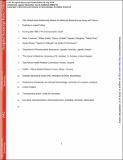Model-based relationship between the molecular bacterial load assay and time-to-positivity in liquid culture
Abstract
The molecular bacterial load (MBL) assay is a new tuberculosis biomarker which provides results in ∼4 hours. The relationship between MBL and time-to-positivity (TTP) has not been thoroughly studied and predictive models do not exist. We aimed to develop a model for MBL and identify the MBL-TTP relationship in patients. The model was developed on data from 105 tuberculosis patients from Malawi, Mozambique and Tanzania with joint MBL and TTP observations quantified from patient sputum collected for 12 weeks. MBL was quantified using polymerase chain reaction (PCR) of mycobacterial RNA and TTP using the Mycobacterial Growth Indicator Tube (MGIT) 960 system. Treatment consisted of isoniazid, pyrazinamide and ethambutol in standard doses together with rifampicin 10 or 35 mg/kg. The developed MBL-TTP model included several linked sub-models; a component describing decline of bacterial load in sputum, another component describing growth in liquid culture and a hazard model translating bacterial growth into a TTP signal. Additional components for contaminated and negative TTP samples were included. Visual predictive checks performed using the developed model gave good description of the observed data. The model predicted greater total sample loss for TTP than MBL due to contamination and negative samples. The model detected an increase in bacterial killing for 35 versus 10 mg/kg rifampicin (p=0.002). In conclusion, a combined model for MBL and TTP was developed that described the MBL-TTP relationship. The full MBL-TTP model or each sub-model used separately. Secondly, the model can be used to predict biomarker response for MBL given TTP data or vice versa in historical or future trials.
Citation
Svensson , R J , Sabiiti , W , Kibiki , G S , Ntinginya , N E , Bhatt , N , Davies , G , Gillespie , S H & Simonsson , U S H 2019 , ' Model-based relationship between the molecular bacterial load assay and time-to-positivity in liquid culture ' , Antimicrobial Agents and Chemotherapy , vol. 63 , no. 10 , e00652-19 . https://doi.org/10.1128/AAC.00652-19
Publication
Antimicrobial Agents and Chemotherapy
Status
Peer reviewed
ISSN
0066-4804Type
Journal article
Collections
Items in the St Andrews Research Repository are protected by copyright, with all rights reserved, unless otherwise indicated.

